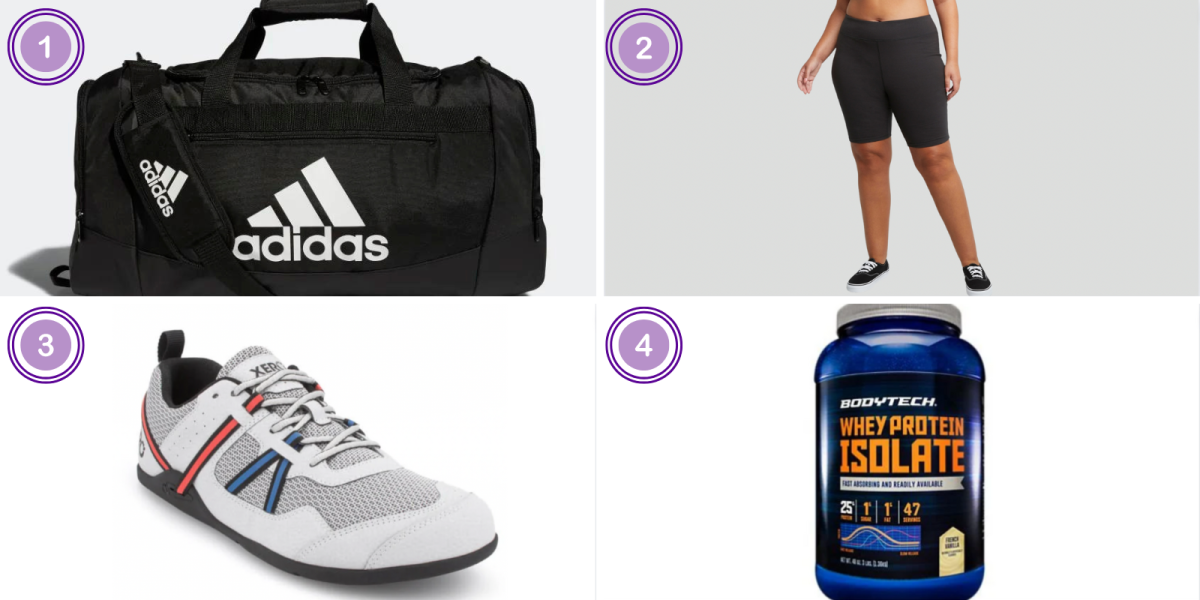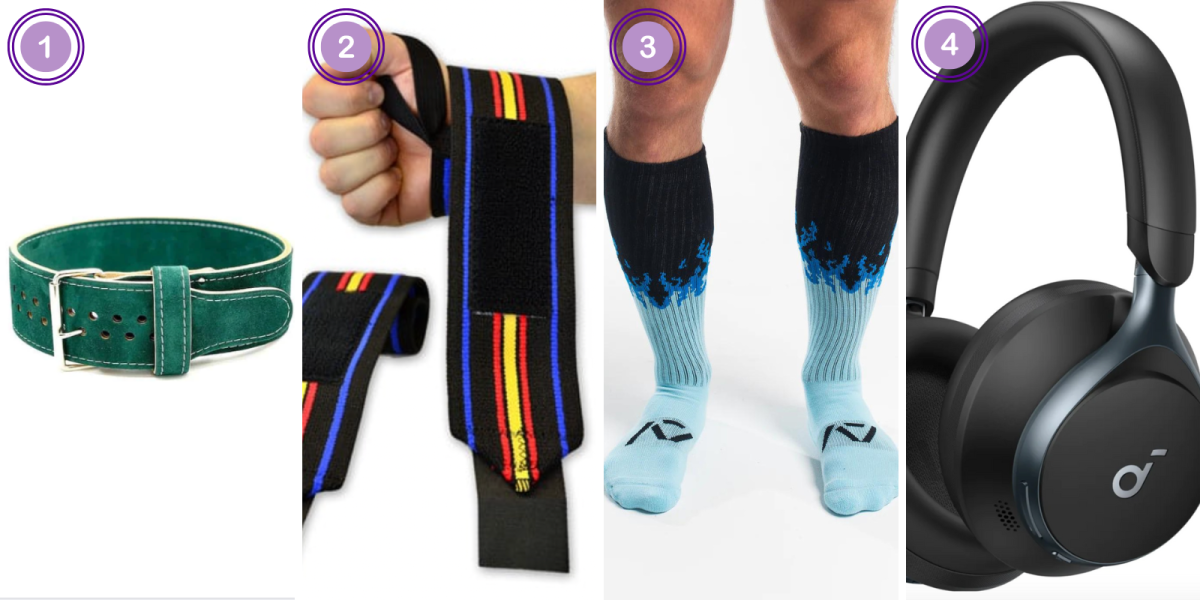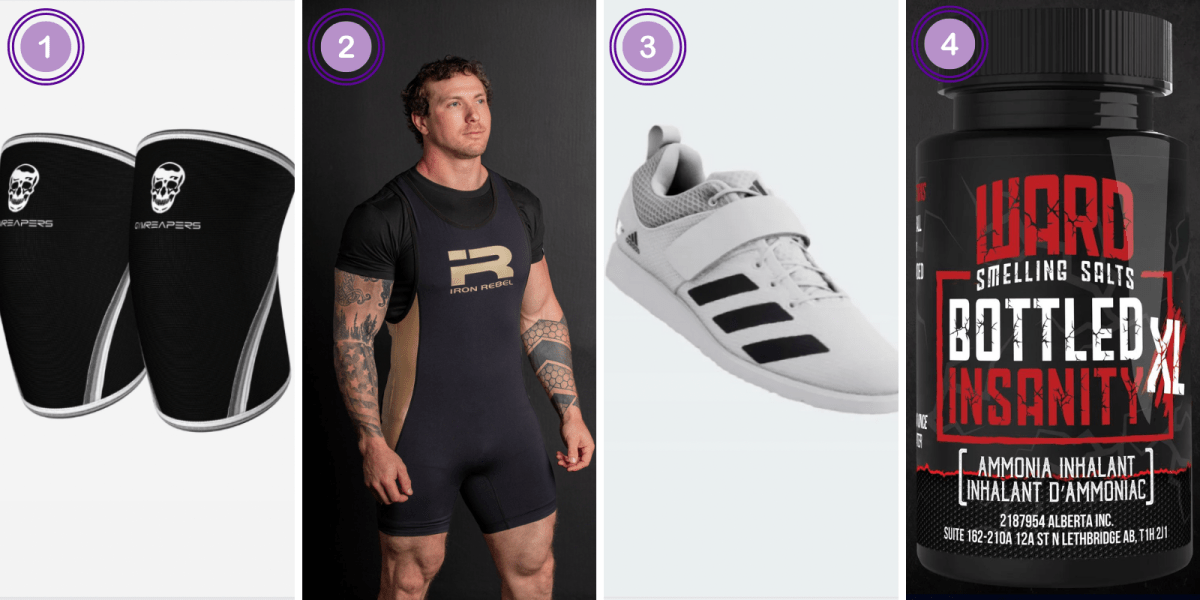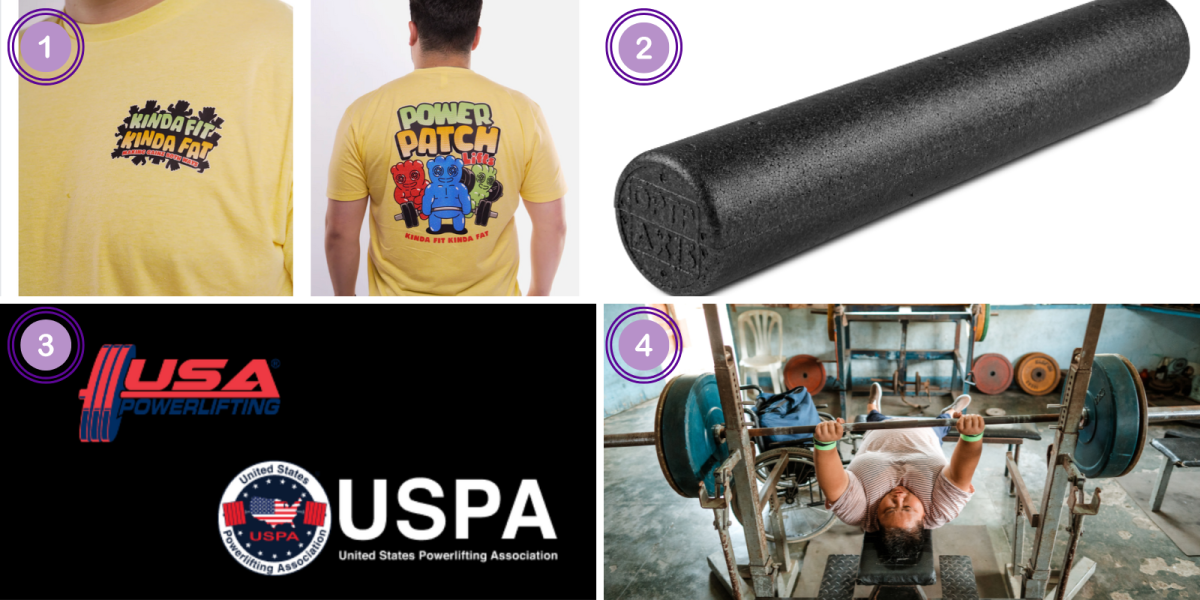Famously, I got into weightlifting last year for one very simple reason and then it became my whole personality. What I’ve learned over the last 15 months is that while weightlifting and powerlifting are simple sports, since you’re basically just picking stuff up and putting it back down, the gear you need to perform your best in the gym becomes more important (and expensive!) as your journey progresses. If you want to keep adding weight to the bar, you have to set yourself up for success and some of that success comes from choosing the items for your body that will give you the correct amount of support (and leverage) to keep doing that.
I will say, though, as someone who didn’t go all in all at once, the weightlifter in your life doesn’t need everything right away. I’m pragmatic, so mostly I think it’s good to do a thing for a while and see how much you like it before fully committing. When I was thinking about writing this gift guide for other lifters, I realized it would be beneficial to reflect that here — you’ll see it’s broken down in different stages, so you can judge where the lifter in your life currently is. In addition to that, I’m including some tighter budget items and more size-inclusive options as well, because I don’t think anyone should be kept from being their best self in the gym just because of finances or lack of available larger sizes.
For When They’re Just Getting Into It

1. Adidas Defender Duffel Bag ($45)
2. Hane’s Bike Shorts ($21)
3. Xero Prio Barefoot Shoes ($90)
4. BodyTech Whey Protein Isolate in French Vanilla (3lb bottle, $65)
When I first started training, I had a beat up old cloth backpack, a pair of Reebok running shoes, and some loose-fitting clothes that I didn’t mind using for the gym. Obviously, at that point, I didn’t realize how important training would become to me but if I could go back in time, I’d give myself this stuff regardless.
A good gym bag that doesn’t cost over $100 is hard to find, and the lifter in your life — no matter what their level is — doesn’t need a bag that costs over $100. The Adidas Defender is perfect: It has a large main compartment, a lot of pockets (including two options for where to store shoes), and it’s waterproof. As far as activewear goes, I’m really into the shorts and pants RASKOL puts out. Their classic bodybuilding shorts, performance shorts, and “dump covers” come in a variety of colors and styles, and recently, they came out with a line of denim-like pants and jorts you can work out in. Mostly though, I train in these Hane’s bike shorts because they’re inexpensive and they stay tight-ish on my body. It’s essential to have a good, flat shoe when you’re performing heavy lifts, so that’s where barefoot shoes really come in handy. Many brands of barefoot shoes are over $150 for some reason, but not Xero Prios. They come in under $100, and they’re perfect. Even my strength coach got on the Prio train after I showed up to the gym with them.
The last thing I’d suggest is to get the lifter in your life started on some important strength-building supplements. With weightlifting, your diet is just as important as your training so it’s important for the lifter in your life to up their protein intake. BodyTech is Vitamin Shoppe’s home brand and personally, I love their whey protein isolate because it’s relatively cheap, often on sale, and tastes good. If I want to splurge, I’ll usually go for something from Ghost’s line of whey proteins. My favorite is the Nutter Butter, but the Cinnabon is great, too. And since you’re already at the supplement store anyways, you should pick up a 100-day supply of Creatine Monohydrate for them. It’ll aid in muscle growth and performance and help their muscles recover after stress.
Now That They’ve Been in It for a Minute

1. Pioneer Double Suede Lever Belt (size xs-xxl, $60-154)
2. Titan Wrist Wraps ($25)
3. A7 Deadlift Socks ($20)
4. Soundcore Space One Wireless Headphones ($70)
I don’t usually train with headphones anymore because my strength gym is small enough that we can control the music playing when we want to but I know not everyone has that precious luxury. I’ve been eyeing these Soundcore Space One Headphones for a while after I saw a couple of other lifters recommend them due to their quality and durability, and they’re most definitely on my list this year for that reason.
Now that I’m getting into extremely heavy lifts in my training, I’m understanding the importance of using equipment that helps keep your body more stable and less likely to fold under the pressure of that heavy lift. Not only that, but we also can’t predict the stability of our joints until we really put them to the test through strength training (and other kinds of sports, I assume). Two things I’d highly recommend getting for the lifter in your life once they’ve decided lifting is truly for them are a powerlifting belt and some wrist wraps. Powerlifting belts help lifters brace their core for heavy lifts, helps reduce the impact on their lower back, and prevents lifters from hyperextending their back while lifting so eventually. It becomes essential. With the powerlifting belt, you have a few different options but mostly it comes down to buckle type. Personally, I prefer the old school weightlifting look of regular buckled belts, and this Pioneer belt has the added bonus of having off-set holes that make it easier to get the perfect fit. However, I know a lot of people prefer lever belts because they can just quickly pop them open when they’re done lifting, and the SBD lever belts are the gold standard because they’re made well and come in extended sizes. Wrist wraps are similarly stabilizing, but specifically for your wrists. Wrists are complex joints and a lot can go wrong with them in a lift before lifters even fully realize it Titan THP Wrist Wraps are the first ones I bought, and I’m going to keep using them for as long as I possibly can.
A good pair of deadlift socks is not as much of a necessity when it comes to performing better, but they might save the lifter in your life some shin pain. A lot of times, our shins get a little beat up from deadlifting, especially if they’re pulling their deadlifts in a particular way or if their gym has older equipment with rougher grooves in the bars. A7 deadlift socks come in a lot of different colors and styles, they’re not too costly, and they’re suitable for competition so they can be used in the gym and on the platform.
Oh, Now They’re Really Cookin’

1. Gym Reapers Knee Sleeves ($60)
2. Iron Rebel All-Star Unisex Singlet ($69)
3. Adidas Powerlift 5 ($130)
4. Ward Smelling Salts ($18)
As the lifter in your life gets more serious about weightlifting and powerlifting, they’re probably often going to be thinking about two things: safely adding as much weight to the bar as possible and training for competition.
If they’ve already most or all of the stuff in the previous section, and it seems like they can’t possibly need or want more stuff, you’re wrong. There are other things they need and want and most likely covet from time to time. Squatting is the most technical lift in powerlifting, and it can also be the hardest to perfect and to overload. (Trust me, I know from personal experience.) Barbell squats demand a lot of the body, and by now, you’ve probably heard the lifter in your life complain a few times about day-after muscle soreness as a result of squatting. So, why not help them do it a little easier and safer? Compression knee sleeves are a good place to start helping because knee sleeves help blood flow to the knee while also keeping it warm, stable, and aligned as lifters squat. That stability can go a long way in terms of preventing injury and improving lifters’ squats overall. There are many options for compression knee sleeves, especially now as weightlifting and powerlifting are gaining some popularity, but I think keeping it simple is best. The Gym Reapers 7 millimeter knee sleeves are simple but also kind of badass because of the design, and compared to a lot of others, they’re super affordable. Personally, I have my sights set on the Iron Rebel performance knee sleeves this year because they have extended sizes and will fit me better than any others.
Speaking of Iron Rebel, if the lifter in your life has been throwing around the idea of competing at a powerlifting meet, I highly recommend their All-Star Unisex Singlet. Not only do they come in extended sizes, but they’re also high quality, not too expensive, and have the perfect inseam length. I just competed in my first meet using this singlet, and believe me, I was happy I went with it. And now that the lifter in your life is really serious, they’re likely going to need some squat shoes, especially if they have any ankle mobility issues (which many of us do!). Squat shoes help make squats more efficient by allowing for even weight distribution throughout the whole foot. Squat shoes can be extremely expensive, sometimes costing upwards of $300, which seems too exorbitant to me. Adidas kind of fills the gap for budget squat shoes by offering two models — the Powerlift 5 and the Adipower 3 — at different price points to fit your financial needs.
Lastly, listen, the lifter in your life is probably going to eventually want some of their own smelling salts. Smelling salts aren’t my favorite thing, but I have witnessed how much they help other lifters get hyped and focused for completing big, max effort lifts. I see Ward Smelling Salts being thrown around a lot as the vanguard for good smelling salts, so I would say start there. They’d make a great stocking stuffer.
Some Extra Stuff They Might Want or Need

1. Kinda Fit, Kinda Fat Power Patch Lift Shirt (xs-6xl, $32)
2. OPTP Black Axis Firm Foam Roller ($11-24)
3. USPA or USAPL Membership (Prices Vary)
4. Strength Coach sessions (Prices Vary)
If you’re noticing the lifter in your life getting more and more serious about their training as the weeks go by, you might also see that commitment leaking into their wardrobe. I don’t have a ton of lifting-themed shirts, but most of the ones I do have come from Kinda Fit, Kinda Fat. I just love the concept of the brand: That lifting and fitness are for anyone, at any size. Also, they come up with some clever graphic t-shirt concepts that I think are fun to wear.
I realize I didn’t talk about it much overall in this guide, but readiness and recovery are critical parts of weightlifting and powerlifting. Luckily, there is one compact tool that can help the lifter in your life accomplish both: A foam roller. Foam rollers can be used before a workout during a warm up to help loosen your muscles and increase the circulation in their body, which could lead to better results throughout their training that day overall. Usually, I use this OPTP Black Axis Firm Foam Roller at home after training to help prevent myofascial adhesions from forming around new muscle growth and to help prevent soreness the following day.
One thing I didn’t know before I decided to sign up for a powerlifting meet with my good friend a few months ago was that you need to be a member of a powerlifting association in order to compete. There are two big powerlifting associations in the U.S. — United States Powerlifting Association and U.S.A. Powerlifting — and most meets (there are tons of meets per year) are hosted and overseen by them. Membership in an association is almost $100 for the year, so it might be a nice gift for the lifter in your life if they’ve been thinking about competing. Before you give this gift, however, just be aware of some issues with participating in powerlifting competitions and in being part of powerlifting organizations. Like most competitive sports, powerlifting is segregated by gender classes in addition to weight and age classes. The USAPL explicitly bans trans lifters from competing in the competitions they moderate, and the USPA allows trans lifters to compete in the non-drug tested division of their competitions. I agree that this is wrong and should be changed (and I have expressed my discomfort with that aspect of competing in a piece I wrote about training for competition), but I’m including it here in case the lifter in your life has expressed some desire to compete. If they have, these are currently the only options available for local, state, and national competition. And even with that, there will always be limitations in regards to which competitions are available in your area or not.
This last one is a different kind of recommendation than the others, but I think it deserves a spot on the list regardless. I know a lot of lifters, from absolute novices to professionals, would agree when I say that a good strength coach is an essential part of progressing in a weightlifting or powerlifting journey. Simply put, strength coaches have the knowledge, skills, and technical know-how to help the lifter in your life crush and surpass their goals while also helping them avoid injury as much as possible and learn how to perfect their lifts. Some sessions with a strength coach in your area might be worth looking into if the lifter in your life has been feeling like they need a little guidance. I’d suggest finding someone by contacting strength gyms and “barbell gyms” in your area to see who’s available for this kind of coaching and to see if they offer any packages you pay for in advance.




Another flat shoe I recommend is the Asics Onitsuka Tiger Mexico 66 slip-on. Cool vintage/retro athletic look and variety of colors. Also come in lace-ups, but I like being able to slip them on an off as a quick change between my squat shoes and doing everything else. I find them really responsive in terms of feeling the floor contact when I deadlift.
I’ve got them for as low as $60, but they are getting a bit trendy so prices really range.
I know looking styly when in the gym isn’t *the* most important thing…but the compliments will really pump. you. up.
Thank you for the suggestion. I have seen those around a little bit! Just generally, I’ve learned from people like the dude behind Squat University that it’s much better (for lifts and for life) to have shoes that have a wider toe box (even for people with narrow feet), which is what attracts me to the barefoot shoes. But also, I think all of this is based on subjective comfort so people should get the things that make them feel the most confident and comfortable!
Ah, yes, good point, and I *do* have almost freakishly narrow feet, now that you mention it! Sadly most all the shoes I’m aesthetically drawn to in life make my toes feel like they’re rattling around in a costco warehouse. Comparatively the Tigers feel nice & snug, which, for me, feels better in the lift. But I definitely take your point. And also appreciate the targeted gift guide AND your content in general, Stef!
As a powerlifter with freakishly narrow feet, I appreciate this rec!
It’s an interesting choice to include powerlifting association membership on this list, and would be worth checking before gifting it, especially for the USAPL, which has explicitly transphobic policies for who can compete and how: https://www.usapowerlifting.com/transgender-participation-policy/
Hi S, thank you for your comment. This is definitely something I considered when making this list…I chose to include them because they are the only options in terms of competition right now and in case a reader’s partner or friend or loved one expressed wanting to compete. I realize I should’ve put a disclaimer in the write up and will be editing it to include that. Thank you again.
Stef!! I love this. Is it maybe just a guide for getting myself gifts? Yes, but, y’know.
I’m not sure what it says about me that I saw the pioneer double suede lever belt and initially thought it was a collar 😂
it says good things :D
I love this for you <3